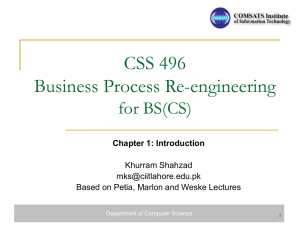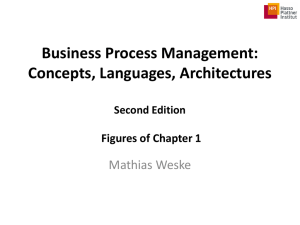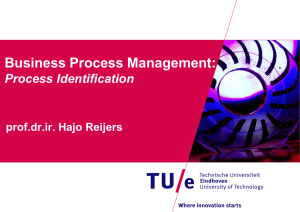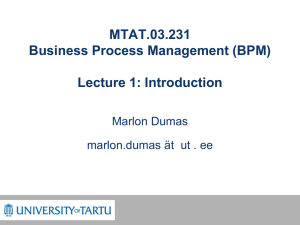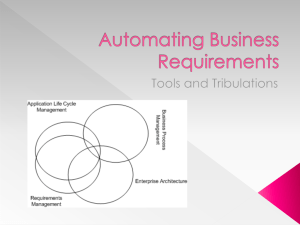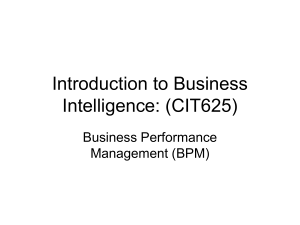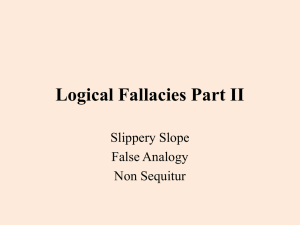Ch 1 (2)
advertisement
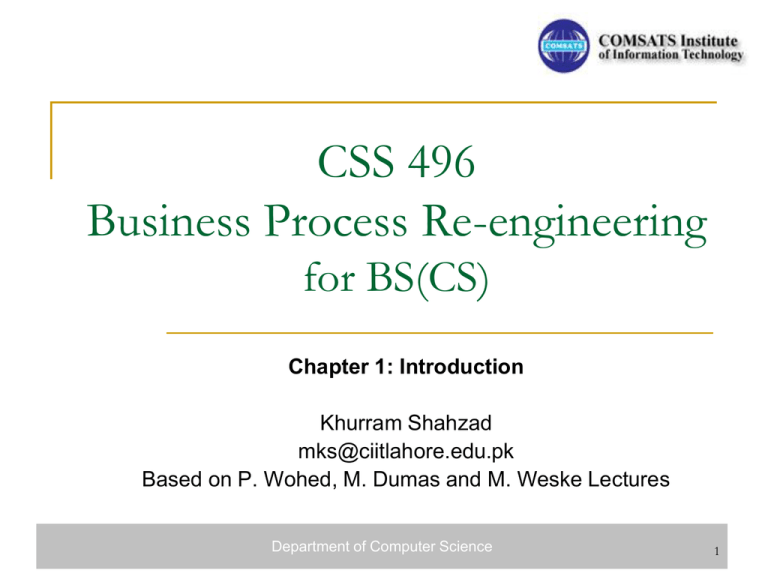
CSS 496 Business Process Re-engineering for BS(CS) Chapter 1: Introduction Khurram Shahzad mks@ciitlahore.edu.pk Based on P. Wohed, M. Dumas and M. Weske Lectures Department of Computer Science 1 Agenda Introduction Course Material Course Evaluation Course Contents Department of Computer Science 2 Muhammad Khurram Shahzad M Khurram Shahzad Assistant Professor M.Sc. from PUCIT, University of the Punjab, PK MS from KTH - Royal Institute of Technology, Sweden 2006 PhD from Information Systems Lab, KTH-Royal Intitute of Technology & Stockholm University, Sweden, (Jan’08 - Inshallah Nov’12) http://syslab.ning.com/profile/mks At least 26 Publications Department of Computer Science 3 Group Webpage Department of Computer Science 4 Research Area I Research in IS focuses on Enterprise Modeling Data Warehousing Academic Social Networks Business Process Management Process Model Repositories Process Improvement using data warehousing Department of Computer Science 5 Department of Computer Science 6 Department of Computer Science 7 Department of Computer Science 8 Research Projects Digital Repository Service for Academic Performance Assessment and Social Networking in Developing Countries Centre for Academic Statistics of Science and Technology Productivity and Social Network Analysis of the BPM Community Department of Computer Science 9 Stockholm University, Sweden Technical University Eindhoven, The Netherlands University of Sri-Jayewardennepura, Sri Lanka Department of Computer Science 10 Course Material Course Book Mathias Weske. Business Process Management: Concepts, Languages, Architectures, Springer, The Netherlands Reference Books M Dumas, W van der Aalst, Arther Hofstede, Process-aware Information Systems: Bridging People and Software through Process Technology, John Wiley & Sons Inc., NY. Department of Computer Science 11 Assignments Implementation/Research on important concepts. To be submitted in groups of 2 students. Include 1. Modeling and Benchmarking of processes 2. Implementation of processes in open source modeling software 3. Literature Review paper on BPM social network May add a couple more Department of Computer Science 12 Lab Work Lab Exercises. To be submitted individually Department of Computer Science 13 Course Introduction BPM is based on the observation that each product that a company provides to the market is the outcome of a number of activities performed Business processes are the key instrument to organizing these activities and to improving the understanding of their interrelationships Department of Computer Science 14 Business Process Management (BPM) BPM is based on the observation that each product that a company provides to the market is the outcome of a number of activities performed Business processes are the key instrument to organizing these activities and to improving the understanding of their interrelationships Department of Computer Science 15 Business Process Management (BPM) A business process consists of a set of activities that are performed in coordination in the organizational and technical environment These activities jointly realize a business goal Each business process is enacted by a single organization, but it may interact with business processes performed by other organizations Department of Computer Science 16 Business Process Management (BPM) Business processes describe the organisation of work into work tasks, the distribution of work task into different resources and the provision of necessary information for the performance of the individual tasks. Examples Order-to-Cash Fault-to-Resolution (Issue-to-Resolution) Claim-to-Settlement Application-to-Approval Department of Computer Science 17 Process and the organization Department of Computer Science 18 Business Process Management (BPM) BPM includes concepts, methods and techniques to support the design, administration, configuration, enactment, and analysis of business processes The basis of BPM is the explicit representation of business processes with their activities and the execution constraints between them Once business processes can be defined, they can be subject to analysis, improvement and enactment Department of Computer Science 19 Business Process Management (BPM) Business process management systems (BPMS) are information systems aimed to support the business processes in an organization A business process management system is a generic software system that is driven by explicit process representation to coordinate the enactment of business processes Department of Computer Science 20 Business Process Management (BPM) Send Invoice Receive Payment Receive Order Archive Order Ship Products Fig 1.1. Simple ordering process of reseller Department of Computer Science M. Weske: Business Process Management, © Springer-Verlag Berlin Heidelberg 2007 Reseller A business process model consists of a set of activity models and execution constraints between them 21 Business Process Management (BPM) A business process instance represents a concrete case in the operational business of a company, consisting of activity instances. Each business process model acts as a blueprint for a set of business process instances, Each activity model acts as a blue print for a set of activity instances Department of Computer Science 22 Terminology around Department of Computer Science 23 The world without computers People performed the entire process The process was visible – one could observe what people did and ask questions There was no need to model the processes Department of Computer Science 24 Assembly line Department of Computer Science 25 Traditional Process (as-is) Department of Computer Science 26 The first computers Department of Computer Science 27 The computer gets several and data moves between them Department of Computer Science 28 Optimization continues Department of Computer Science 29 Consequences The process is hidden in the systems and no longer visible for the people. It is no more simple to “see” the whole by simply observing how people work. The IT-departments have unconsciously got the responsibility for big part of the business processes, which was of course never the intention. Department of Computer Science 30 My washing machine won’t work Department of Computer Science 31 Processes and Outcomes Every process leads to one or several outcomes, positive or negative Fault-to-resolution process Fault repaired without technician intervention Fault repaired with minor technician intervention Fault repaired and fully covered by warranty Fault repaired and partly covered by warranty Fault repaired but not covered by warranty Fault not repaired (customer withdrew request) Department of Computer Science 32 The Ford Case Study (Hammer 1990) Ford needed to review its procurement process to: Do it cheaper (cut costs) Do it faster (reduce turnaround times) Do it better (reduce error rates) Accounts payable in North America alone employed > 500 people and turnaround times for processing POs and invoices was in the order of weeks Department of Computer Science 33 The Ford Case Study Automation would bring some improvement (20% improvement) But Ford decided not to do it… Why? Because at the time, the technology needed to automate the process was not yet available Because nobody at Ford knew how to develop the technology needed to automate the process. Because there were not enough computers and computer-literate employees at Ford. None of the above Department of Computer Science 34 The result… 75% reduction in head count Material control is simpler and financial information is more accurate Purchase requisition is faster Less overdue payments Why automate something we don’t need to do? Automate things that need to be done. Department of Computer Science 35 Business Process Lifecycle Evaluation: Evaluation Design: Enactment: Operation Monitoring Maintenance Enactment Administration and Stakeholders Design & Analysis Business Process Identification and Modeling Analysis: Configuration Validation Simulation Verification M. Weske: Business Process Management, © Springer-Verlag Berlin Heidelberg 2007 Process Mining Business Activity Monitoring Configuration: System Selection Implementation Test and Deployment Fig 1.5. Business process lifecycle Department of Computer Science 36 Design and Analysis Surveys on process and their organizational and technical environment are conducted Based on these surveys, processes are identified, reviewed, validated, and represented by business process models Explicit process models expressed in graphical notation facilitate communication about these processes, so that stakeholders can communicate efficiently refine and improve them Department of Computer Science 37 Design and Analysis Three good reasons making models Gain Insights For a better understanding of a system Analysis for Validation and verification Specification A blueprint of construction Department of Computer Science 38 Design and Analysis We will investigate languages to express business process models Modeling techniques as well as validation, simulation, and verification techniques are used during this phase Once initial design is developed, it needs to be validated (using workshop) Simulation techniques can be used to support validation because certain undesired execution sequences might be simulated that show deficits in the process models Department of Computer Science 39 Design and Analysis Process modeling has an evolutionary character in the sense that the process model is analyzed and improved so that it actually represents the desired business process and that it does not contain any undesired properties like deadlock We will investigate the verification of process models with respect to correctness properties Department of Computer Science 40 Configuration Once process model is designed and verified, the process needs to be implemented There are different ways for it: As a set of policies and procedures that enterprise has to comply with Realization without BPMS System is configured according to organizational environment It includes interaction of employees with system And integration of existing software systems with BPMS Department of Computer Science 41 Enactment Once configuration is completed, process instances can be enacted Enactment encompasses the actual runtime of the business process BPMS actively controls the execution of instances as defined in process models i.e. activities are performed according to the execution constraints specified in process model Monitoring component visualizes the stauts of process instances Department of Computer Science 42 Enactment Information is valuable, for instance to respond to a customer request that inquires about the current status of his case During enactment, valuable execution data is gathered, typically in some form of log file Log files consists of ordered sets of log entries, indicating events that have occurred during processes Department of Computer Science 43 Evaluation Uses the information available to evaluate and improve process models and their implementations Execution logs evaluation Business activity monitoring For instance, it can identify that a certain activity takes too long due to shortage of resources required Process Mining If applied on traditional IS, process models can be generated Department of Computer Science 44 Administration and Stakeholders Numerous artifacts at different levels of abstraction that needs to be organized and managed A well structure repository with powerful query mechanisms is essential Classification of roles of Stakeholders Chief Process Officer Responsible for standardizing and harmonizing processing Acknowledges important of BPM to top level managenment Department of Computer Science 45 Administration and Stakeholders Business Engineer; domain experts, non technical Process Designer; modeling processes by communicating with domain experts Process Participant; Knowledge Worker Process Responsible System Architect Developers Department of Computer Science 46 Business Process Lifecycle Evaluation: Evaluation Design: Enactment: Operation Monitoring Maintenance Enactment Administration and Stakeholders Design & Analysis Business Process Identification and Modeling Analysis: Configuration Validation Simulation Verification M. Weske: Business Process Management, © Springer-Verlag Berlin Heidelberg 2007 Process Mining Business Activity Monitoring Configuration: System Selection Implementation Test and Deployment Fig 1.5. Business process lifecycle Department of Computer Science 47 Classification of Business Processes Organizational vs Operational Intra-organizational Processes vs Process Choreographies Degree of Automation Degree of Repetition Department of Computer Science 48 Classification of Business Processes Business Strategy Organizational vs Operational determines Ranges from high-level strategy to implemented processes Business Strategy describes longterm concepts to develop a sustainable competitive advantage e.g. cost leadership for products Strategy is broken down into operational goals e.g. Reducing the cost of material realize Goals determine realize Organizational Business Processes determine realize Operational Business Processes determine M. Weske: Business Process Management, © Springer-Verlag Berlin Heidelberg 2007 realize Implemented Business Processes Fig 1.6. Levels of business processes: from business strategy to implemented business processes Department of Computer Science 49 Classification of Business Processes Business Strategy Organizational Processes High level Specified in textual form by determines realize Goals determine Inputs Outputs Expected results Dependencies on other processes realize Organizational Business Processes determine realize Operational Business Processes e.g. process to manage incoming raw materials provided by a set of suppliers determine M. Weske: Business Process Management, © Springer-Verlag Berlin Heidelberg 2007 realize Implemented Business Processes Fig 1.6. Levels of business processes: from business strategy to implemented business processes Department of Computer Science 50 Classification of Business Processes Business Strategy Operational Processes determines There are multiple organizational processes that contribute to organizational process In operational processes activities and their relationships are specified Operational process are specified by process models realize Goals determine realize Organizational Business Processes determine realize Operational Business Processes determine M. Weske: Business Process Management, © Springer-Verlag Berlin Heidelberg 2007 realize Implemented Business Processes Fig 1.6. Levels of business processes: from business strategy to implemented business processes Department of Computer Science 51 Classification of Business Processes Business Strategy Operational Processes are basis for developing implemented processes Implemented processes contain information on the determines realize Goals determine realize Organizational Business Processes determine execution of process activities technical and organizational environment in which they will be executed realize Operational Business Processes determine M. Weske: Business Process Management, © Springer-Verlag Berlin Heidelberg 2007 realize Implemented Business Processes Fig 1.6. Levels of business processes: from business strategy to implemented business processes Department of Computer Science 52 Classification of Business Processes Organizational vs Operational Intra-organizational Processes vs Process Choreographies Degree of Automation Degree of Repetition Department of Computer Science 53 Classification of Business Processes Intra-organizational processes, no interaction with processes performed by other parties Primary focus is to streamline internal processes (eliminate activities that do not bring value) Allocate activities to persons who are skilled and competent Most business processes interact with processes in other organizations forming process choreographies Interaction protected by legally binding contracts More technical aspects are involved here because different organizations use different software platforms Department of Computer Science 54 Classification of Business Processes Organizational vs Operational Intra-organizational Processes vs Process Choreographies Degree of Automation Degree of Repetition Department of Computer Science 55 Classification of Business Processes Degree of automation Fully automated, no human is involved e.g. airline ticket using web interfaces Many processes require manual activities, but also include automated activities e.g. insurance claim Department of Computer Science 56 Classification of Business Processes Degree of Repetition Highly repetitive, include business processes without human involvement e.g. online ticketing Process that occur few times e.g. large engineering efforts like designing a vessel If repetitive process modeling, automation If not repetitive process modeling and automation is questionable due to high cost Department of Computer Science 57 Classification of Business Processes Degree of structuring Either highly structured (rigid) or flexible for knowledge workers. Data dependencies are used instead of control flow constraints Department of Computer Science 58
